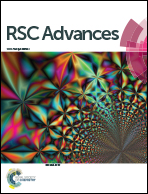Preparation of platinum nanoparticles using iron(ii) as reductant and photosensitized H2 generation on an iron storage protein scaffold†
Abstract
The quest for efficient solar-to-fuel conversion has led to the development of numerous homogeneous and heterogeneous systems for photochemical stimulation of 2H+ + 2e− → H2. Many such systems consist of a photosensitizer, an H2-evolving catalyst (HEC), and sacrificial electron donor often with an electron relay between photosensitizer and HEC. Colloidal platinum remains a popular HEC. We report here a novel, simple, and high yield synthesis of Pt nanoparticles (Pt NPs) associated with human heavy chain ferritin (Hfn). The formation of the Pt NPs capitalizes on Hfn's native catalysis of autoxidation of Fe(II)(aq) (ferroxidase activity). Fe(II) reduces Pt(II) to Pt(0) and the rapid ferroxidase reaction produces FeO(OH), which associates with and stabilizes the incipient Pt NPs. This Pt/Fe-Hfn efficiently catalyzes photosensitized H2 production when combined with Eosin Y (EY) as photosensitizer and triethanolamine (TEOA) as sacrificial electron donor. With white light irradiation turnover numbers of 300H2 per Pt, 250H2 per EY were achieved. A quantum yield of 18% for H2 production was obtained with 550 nm irradiation. The fluorescence emission of EY is quenched by TEOA but not by Pt/Fe-Hfn. We propose that the photosensitized H2 production from aqueous TEOA, EY, Pt/Fe-Hfn solution occurs via a reductive quenching pathway in which both the singlet and triplet excited states of EY are reduced by TEOA to the anion radical, EY−˙, which in turn transfers electrons to the Pt/Fe-Hfn HEC. Hfn is known to be a remarkably versatile scaffold for incorporation and stabilization of noble metal and semiconductor nanoparticles. Since both EY and Hfn are amenable to scale-up, we envision further refinements to and applications of this photosensitized H2-generating system.



 Please wait while we load your content...
Please wait while we load your content...